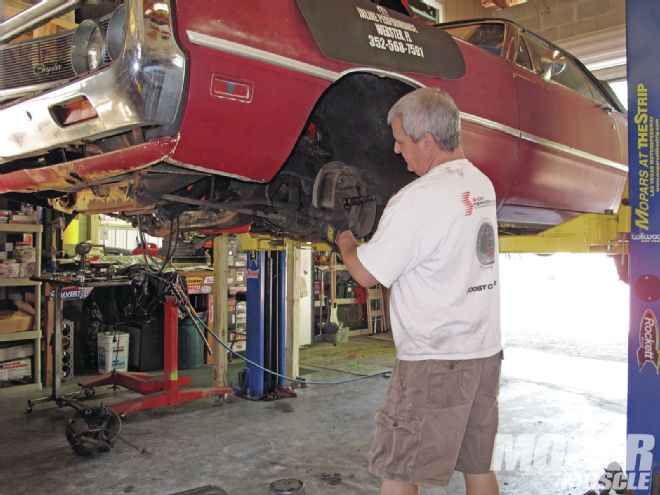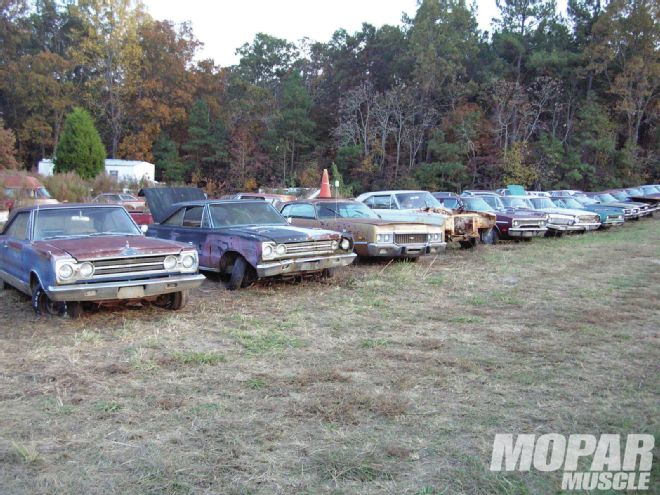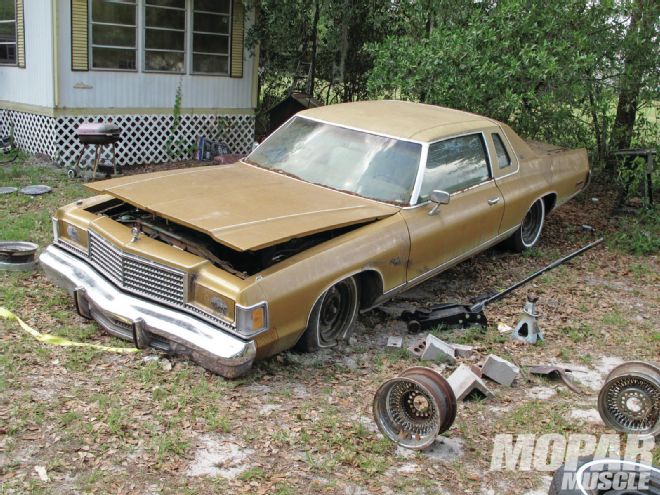
There’s nothing like the road presence, or the ride, of a Mopar C-Body, so when we picked up this Chrysler Newport convertible several months ago we were eager to get it in roadworthy condition. You might remember this car from a recent Hidden Treasures article, after which we got the engine and transmission revived with a bunch of new parts from Rockauto.com. But since the car had been sitting so long, the original drum brakes were deemed untrustworthy, keeping us from taking the big boat for a cruise until we could make some repairs.
Up front, we’ll upgrade the brakes, replacing the drums with a set of second-hand ’72 C-Body disc brakes we got when we bought the car. In the rear, we’ll simply rebuild the original 11-inch drum brakes with new parts from Rockauto.com, as the C-Body rear brakes are some of the best, and biggest, factory drum brakes available. Combined with a new master cylinder, power brake booster, and a set of new tires from General Tire, our C-Body should be ready to hit the road for some safe cruising.
If you’ve never experienced owning, driving, or riding in a Chrysler C-Body, you’ve really missed out on a fun part of our hobby. These cars are large, massive really, and their sheer size gives the driver and passengers the solid reassurance of a sheetmetal cocoon. And this sheetmetal isn’t the kind found on your local Kia dealer’s lot, this stuff is only a gauge or two down from plate steel, the kind used in tanks and battle ships.
But while it is encouraging to be surrounded by so much metal, there is a downside, which is extra weight. As a function of their size, some C-Bodys can tip the scales at nearly three tons when fully loaded, creating a sizable mass to bring to a stop in rush-hour traffic. We felt that in the interest of safety, our Newport’s questionable original front drum brakes had to go.
From the factory, Mopar cars had some of the best drum brakes for their time, measuring up to 11 inches in diameter. Drum brakes aren’t what we would call a performance braking system, however, adequate for the rear but not for the front of a heavy C-Body. Luckily, we obtained a set of factory disc brake spindles from the previous owner, along with rebuilt calipers, new pads, and freshly cut rotors.
He had rebuilt these brakes for a ’72 Dodge station wagon but couldn’t get a title for the car and had to scrap it. Before the car left, he cut the brakes off and saved them for the Newport, including them in the sale to sweeten the deal for us. After installing the disc brakes up front, we’ll rebuild the rear drum brakes, install a new master cylinder with replacement parts from Rockauto.com, then bleed the system completely.
We got lucky and got our brake swap parts in the deal with the car, but you can still find C-Bodies to get the required parts from. We aren’t sure why, but there seem to be more C-Body "survivor" cars around, and we still see them in the local junkyards, backyards, and barns around town. These cars have seemed to last longer than other Mopars, likely because they weren’t abused as much, and therefore you can still find donor cars in junkyards to get the front spindles for the disc brake conversion.
Any 1969 and up Mopar C-Body with single-piston front disc brakes will work, but stay away from the earlier four-piston calipers. While the four-piston brakes are arguably more efficient, they are also four times as likely to leak, and expensive to re-sleeve if corroded.
In the rear, the C-Body 11-inch drum brakes are adequate for a driver car when used in conjunction with front disc brakes. And while we won’t rule out a rear truck drum or disc conversion for this car sometime in the future, we’ll just rebuild the factory brakes for now and get the car on the road.
So long as they are properly proportioned, 11-inch drum brakes are actually not just adequate, but a decent brake for the rear, able to lock up even large tires repeatedly without building excessive heat. New pads, wheel cylinders, and hardware from Rockauto.com will get our rear drums in working order and our car closer to being drivable.

Of course these brake upgrades will only work if the tires are sufficient to control the braking action, so we ordered a set of new 15-inch radials from General Tire for the Newport. New tires should always be considered a mandatory upgrade, especially in a case like our car which had been sitting for many years. The 235/75R15 General Grabber A/W radials we chose offer good wet and dry performance, semi-aggressive tread, and 420 treadware, B traction, and B heat ratings.
These tires are light-years ahead of the skinny bias-ply tires our car was built with and should greatly enhance the ride and performance of our Newport. We plan to drive this car regularly, and new tires not only perform better, but are more resilient to nails and flat-causing debris, enhancing our car’s reliability. Time to go to work and get our C-body one step closer to some top-down cruising.

There’s no doubt that most Mopars are harder and harder to find sitting in scrap yards, or anywhere for that matter, making it difficult to perform repairs with second-hand parts. Fortunately, the exception to this rule seems to be the C-Body. These cars appear to have weathered the storm when compared to more desirable body styles, and we still see them driving around, sitting in storage lots or behind houses, and even showing up in the local junkyards. Since these cars were family cars, many of them were simply abused less and taken care of better than other body styles, then passed down to future generations of drivers. And while C-Bodies may not be as light as other Mopars, we still think they’re some of the coolest cars produced by the Chrysler Corporation. So even if you can’t find the part you need locally, we have several advertisers that deal in pre-owned parts. Just check out their advertisements in Mopar Muscle and help keep C-Bodies on the road! - Editor